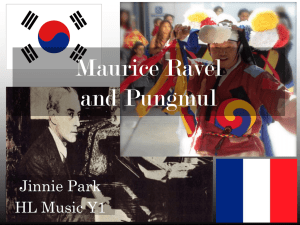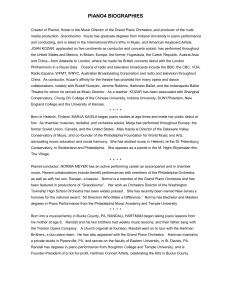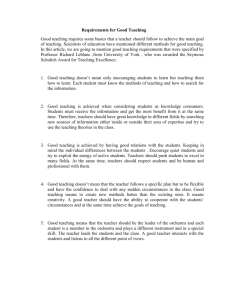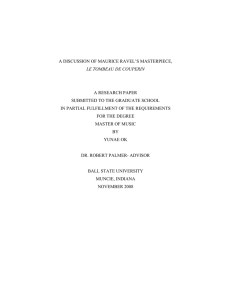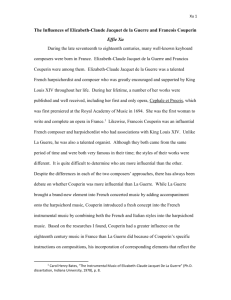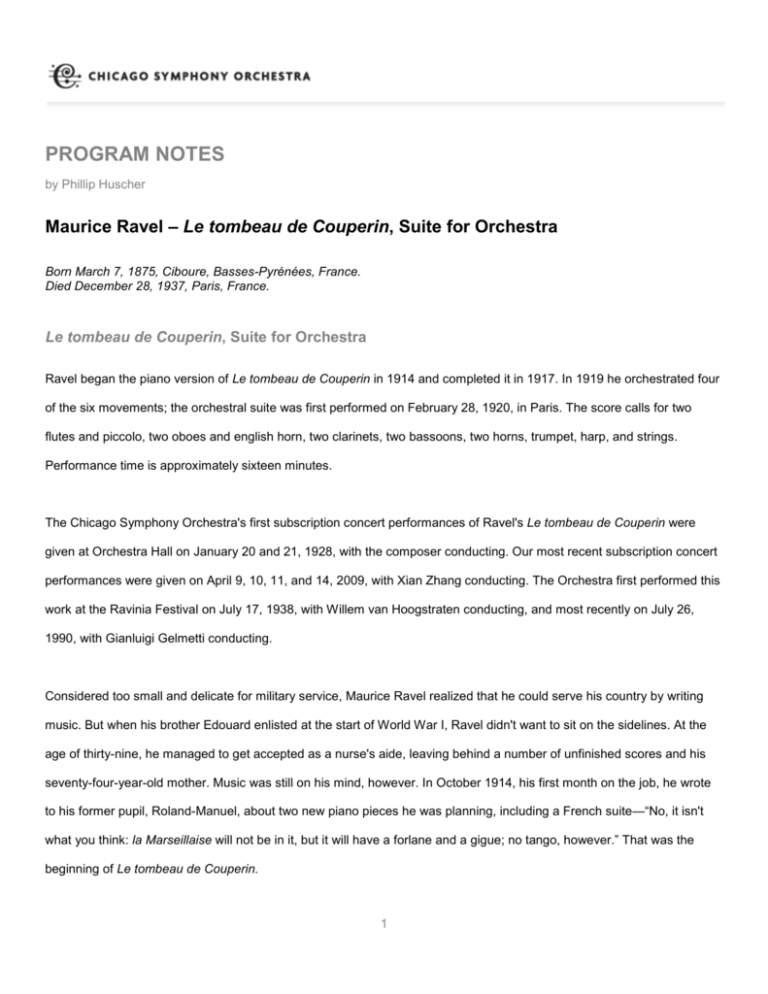
PROGRAM NOTES
by Phillip Huscher
Maurice Ravel – Le tombeau de Couperin, Suite for Orchestra
Born March 7, 1875, Ciboure, Basses-Pyrénées, France.
Died December 28, 1937, Paris, France.
Le tombeau de Couperin, Suite for Orchestra
Ravel began the piano version of Le tombeau de Couperin in 1914 and completed it in 1917. In 1919 he orchestrated four
of the six movements; the orchestral suite was first performed on February 28, 1920, in Paris. The score calls for two
flutes and piccolo, two oboes and english horn, two clarinets, two bassoons, two horns, trumpet, harp, and strings.
Performance time is approximately sixteen minutes.
The Chicago Symphony Orchestra's first subscription concert performances of Ravel's Le tombeau de Couperin were
given at Orchestra Hall on January 20 and 21, 1928, with the composer conducting. Our most recent subscription concert
performances were given on April 9, 10, 11, and 14, 2009, with Xian Zhang conducting. The Orchestra first performed this
work at the Ravinia Festival on July 17, 1938, with Willem van Hoogstraten conducting, and most recently on July 26,
1990, with Gianluigi Gelmetti conducting.
Considered too small and delicate for military service, Maurice Ravel realized that he could serve his country by writing
music. But when his brother Edouard enlisted at the start of World War I, Ravel didn't want to sit on the sidelines. At the
age of thirty-nine, he managed to get accepted as a nurse's aide, leaving behind a number of unfinished scores and his
seventy-four-year-old mother. Music was still on his mind, however. In October 1914, his first month on the job, he wrote
to his former pupil, Roland-Manuel, about two new piano pieces he was planning, including a French suite—“No, it isn't
what you think: la Marseillaise will not be in it, but it will have a forlane and a gigue; no tango, however.” That was the
beginning of Le tombeau de Couperin.
1
In March 1915, Ravel became a truck driver for the 13th Artillery Regiment. (He named the truck Adélaïde and signed his
letters Chauffeur Ravel.) It was a dangerous, exhausting, and stressful assignment, and his health suffered. At least for a
while, music took a back seat to the more pressing concerns of life and death. Early in 1917, his mother died; it was a
terrible blow, which contributed even further to his physical and mental decline, and he was discharged from the army a
few months later. While recuperating at his godmother's country house, Ravel returned to writing music, beginning with
the French suite for piano.
Ravel had been tempered by his first-hand experience of war. A frothy symphonic poem, Vien, which he abandoned
during the war, now became the bitter La valse. And the benign piano suite he had long envisioned, perhaps as a genial
bit of nationalism, now carried the horrible weight of tragedy: each movement was dedicated to a friend who had died at
the front. Back in familiar surroundings, but still haunted by memories of the war, Ravel completed the suite he now called
Le tombeau de Couperin. What had begun as a homage to a golden era of French music—the age of François Couperin
and the eighteenth century in general—now paid gentle tribute to the victims of World War I. Ravel designed his own title
page for the score, which included a draped funerary urn. The piano suite contained six movements; as the composer
promised, there was no hint of the Marseillaise. (Nor was there any tango, perhaps because that popular dance was then
thought too scandalous for the concert hall.)
Before the war, Ravel's own orchestrations of his piano pieces Mother Goose and the Valses nobles et sentimentales
were wildly popular. In 1919, after the first performance of Le tombeau de Couperin, he began to orchestrate four of the
six movements. As Roland-Manuel wrote, “This metamorphosis of piano pieces into symphonic works was a game for
Ravel, a game played to perfection, so that the transcription outdid the charm of the original.” Le tombeau de Couperin is
arguably Ravel's greatest success in the sport. The translation from piano to full orchestra is handled with an almost
impossible finesse; Ravel carefully weighed every choice of instrument, showing impeccable concern for color, in all its
subtle modulations, as well as for clarity and balance. The orchestration is a work of both enormous care and extreme
economy.
Le tombeau de Couperin is the most gentle of war memorials—it's about memory, not combat. It has neither the morbid
sadness of Richard Strauss's Metamorphosen nor the anger of Dmitri Shostakovich's grand wartime symphonies. It
2
evokes those it honors, not the tragic circumstances of their deaths. Ravel borrows the forms of the baroque dance suite,
beginning with a prelude that sets the presiding graceful tone. (The piano version includes a fugue and a toccata that
Ravel chose not to orchestrate.) The second movement is a forlane, a Northern Italian dance; before composing a note of
his own, Ravel transcribed a forlane by Couperin as a way of getting to know the style. Ravel's Menuet (like the Prélude)
gives the oboe a prominent role. The Rigaudon that concludes Ravel's suite is an old dance from Provence that was
sometimes used by Rameau and Bach, and much later by Grieg in his Holberg Suite, though seldom with such brilliance
and panache.
For the Record
The Chicago Symphony Orchestra recorded Ravel's Le tombeau de Couperin in 1980 with Sir Georg Solti conducting for
London. A 1983 performance under Rafael Kubelík is included on From the Archives, vol. 16: A Tribute to Rafael Kubelík
II.
Phillip Huscher is the program annotator for the Chicago Symphony Orchestra.
© by the Chicago Symphony Orchestra. All rights reserved. Program notes may not be reproduced; brief excerpts may be
quoted if due acknowledgment is given to the author and the Chicago Symphony Orchestra.
These notes appear in galley files and may contain typographical or other errors. Programs and artists subject to change
without notice.
3

